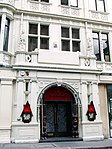Crockford's (club)

Crockford's, the popular name for William Crockford's St James's Club was a London gentlemen's club, now dissolved. It was established in 1823, closed in 1845, re-founded in 1928 and closed in 1970. One of London's older clubs, it was centred on gambling and maintained a somewhat raffish and raucous reputation. It was founded by William Crockford who employed Benjamin Wyatt and Philip Wyatt to construct the city's most opulent palace of gentlemanly pleasure, which opened in November 1827. and he employed two of London's finest chefs of the time, Louis Eustache Ude and then Charles Elmé Francatelli to feed its members, food and drink being supplied free after midnight.From 1823, the club leased 50 St. James's Street, and then nos. 51–53, which enabled Crockford to pull down all four houses and build his palatial club on the site. After the club's closure, this continued to be used as a clubhouse, at first briefly by the short-lived Military, Naval and County Service Club, and then between 1874 and 1976 it was home to the Devonshire Club. The current Crockfords, though using much of the "Crocky" imagery and high-end reputation, has no connection with the original club and operates from an entirely different building at nearby 30 Curzon Street.
Excerpt from the Wikipedia article Crockford's (club) (License: CC BY-SA 3.0, Authors, Images).Crockford's (club)
Piccadilly, City of Westminster Mayfair
Geographical coordinates (GPS) Address Phone number Website Nearby Places Show on map
Geographical coordinates (GPS)
| Latitude | Longitude |
|---|---|
| N 51.507387 ° | E -0.140579 ° |
Address
The Wolseley
Piccadilly 157-160
W1J 9EB City of Westminster, Mayfair
England, United Kingdom
Open on Google Maps





